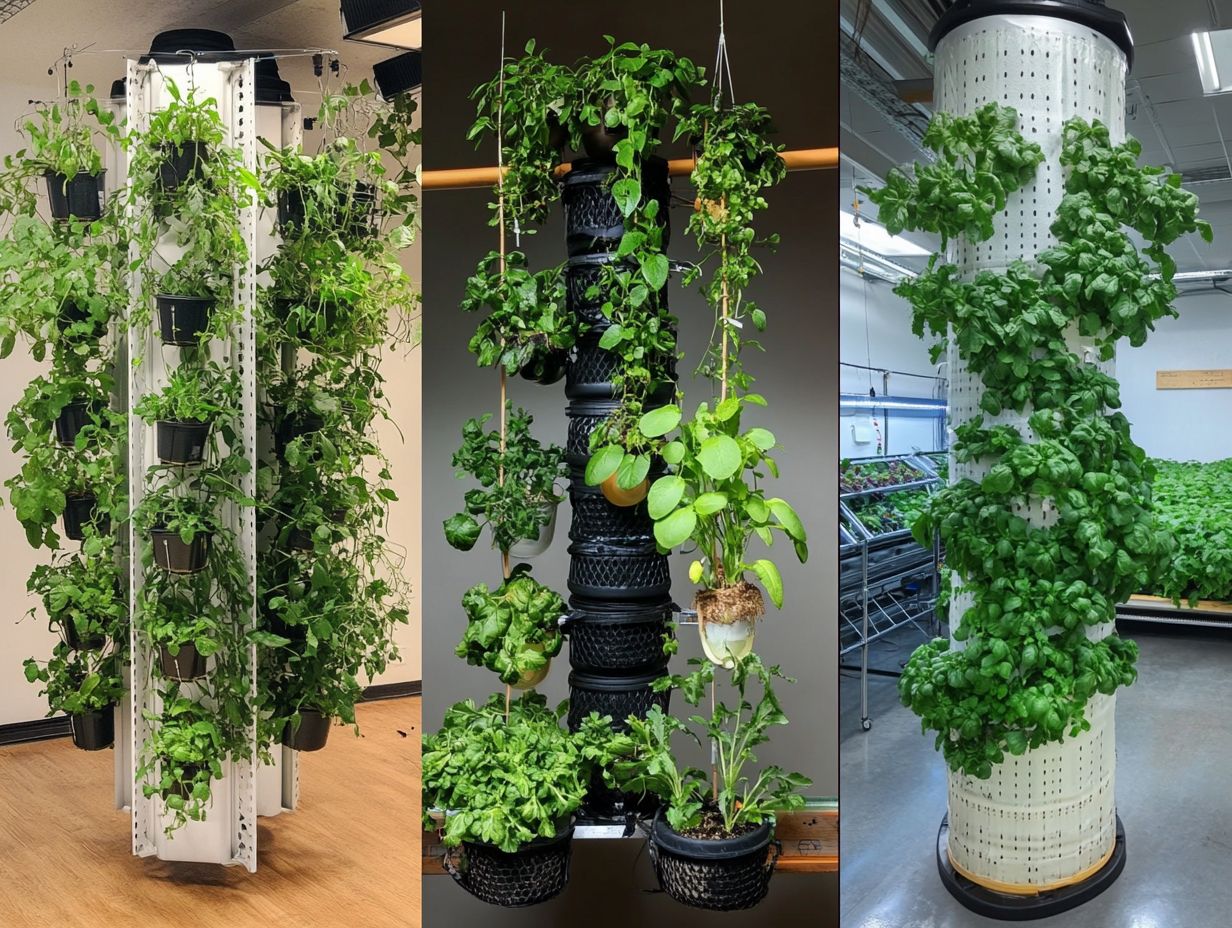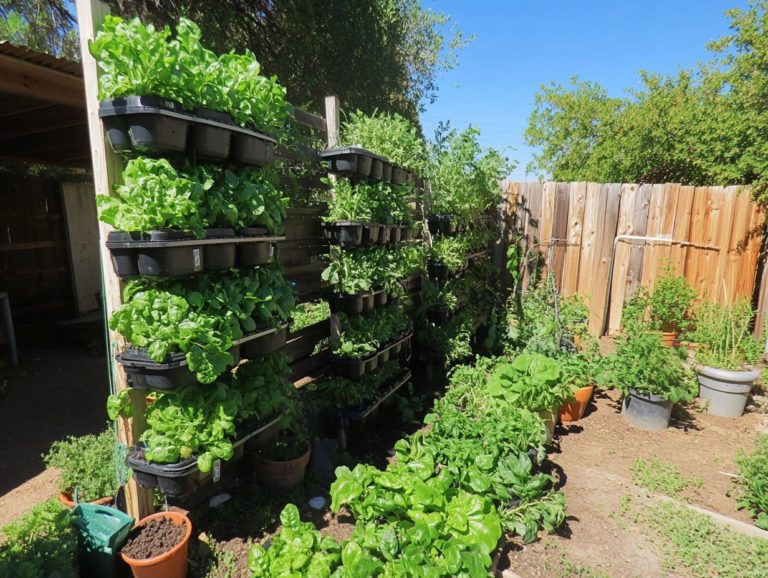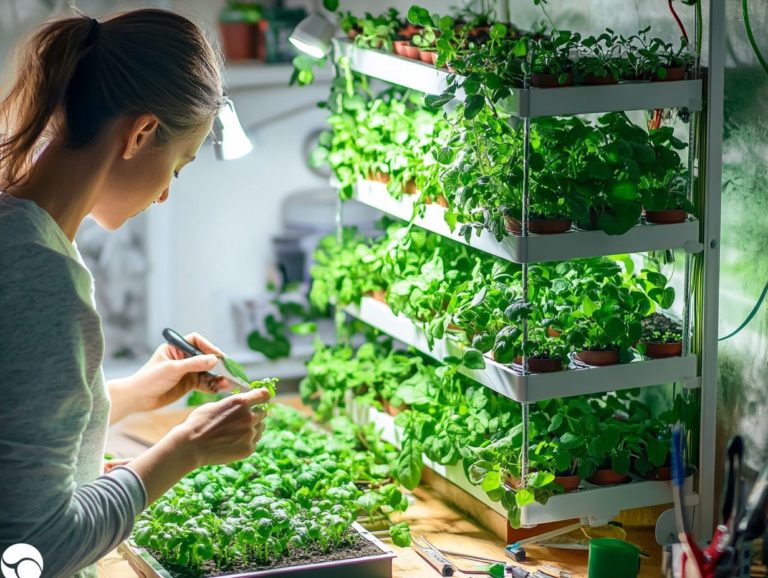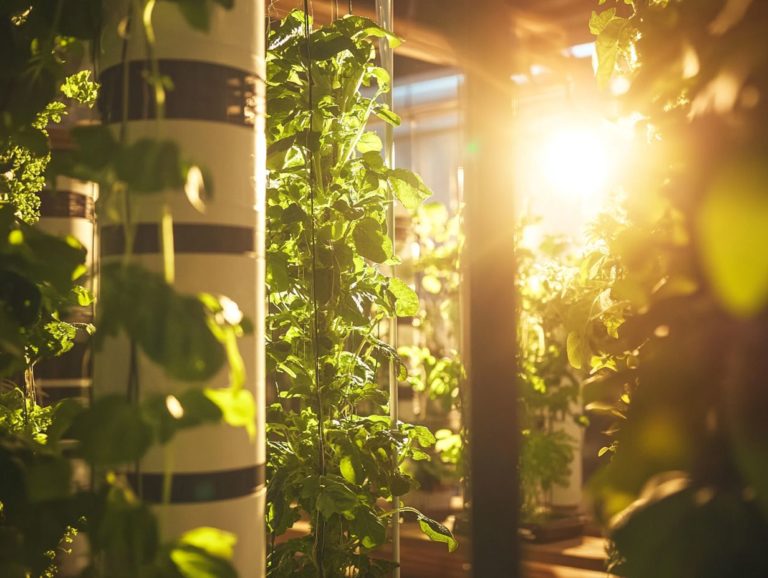5 Hydroponic Growing Systems You Can Build Yourself
Hydroponic gardening unveils a remarkable realm of possibilities, enabling you to grow plants without the constraints of soil. You can grow plants all year long, and they grow faster too.
Whether you find yourself as a seasoned gardener or an eager novice, constructing a hydroponic system can be an incredibly rewarding and enjoyable endeavor. This article also covers the benefits, essential materials, maintenance tips, and guidance on selecting the best plants for your project. Prepare to elevate your gardening experience to new heights!
Contents
- Key Takeaways:
- 1. Basic Wick System
- 2. Deep Water Culture System
- 3. Ebb and Flow System
- 4. Drip System
- 5. Nutrient Film Technique System
- What Is Hydroponic Gardening and How Does It Work?
- What Are the Benefits of Using a DIY Hydroponic System?
- What Materials Do You Need to Build a DIY Hydroponic System?
- How Can You Maintain and Troubleshoot Your DIY Hydroponic System?
- What Are the Best Plants to Grow in a DIY Hydroponic System?
- How Can You Take Your DIY Hydroponic System to the Next Level?
- Frequently Asked Questions
- What is hydroponic growing and why should I consider building my own system?
- What are the benefits of using a hydroponic growing system?
- What are the different types of hydroponic growing systems that can be built at home?
- What materials are needed to build a DIY hydroponic growing system?
- Are there any potential drawbacks to building a DIY hydroponic growing system?
- Is it difficult to build and maintain a hydroponic growing system?
Key Takeaways:

1. Basic Wick System
The Basic Wick System offers a straightforward and effective hydroponic method, perfect for home gardening enthusiasts like you. It allows for effortless plant growth without the complexities of advanced systems, making it an excellent choice for beginners eager to embrace eco-friendly gardening practices while maximizing their fresh produce yield.
This system harnesses capillary action (the ability of water to rise in thin tubes or absorb into materials) to draw nutrient-rich water from a reservoir directly to your plant roots, ensuring they receive consistent moisture. By selecting various growing mediums such as coconut coir, perlite, or rock wool, you can create an optimal environment for your plants to thrive.
Regular maintenance is a breeze; simply check the wick for blockages and ensure that your nutrient solution is replenished periodically. A wide variety of plants flourish in this uncomplicated setup, including herbs like basil and mint as well as leafy greens such as lettuce and spinach. It s truly an ideal choice for anyone new to hydroponics.
2. Deep Water Culture System
Deep Water Culture (DWC) stands out as a premier hydroponic system, immersing your plant roots in a nutrient solution that ensures they have constant access to essential nutrients and oxygen. With constant nutrients and oxygen, your plants will thrive and produce delicious, fresh food!
This method beautifully marries the simplicity of traditional gardening with cutting-edge techniques, offering you an efficient and effective approach to cultivation. Proper aeration plays a pivotal role in DWC systems; by using air pumps and air stones, you can ensure that oxygen is adequately diffused throughout the water, fostering robust root development.
Maintaining water quality is essential for your success, requiring you to regularly monitor pH levels and nutrient concentrations. Aim for a pH level between 5.5 and 6.5, and utilize specific nutrient solutions designed for your plants growth stages. Consistently checking these parameters will help you avert issues like root rot and nutrient deficiencies, ultimately leading to a flourishing hydroponic garden that you can take pride in.
3. Ebb and Flow System
The Ebb and Flow System is a versatile hydroponics method that periodically floods your growing area with a nutrient solution, ensuring your plants receive both water and oxygen efficiently for optimal growth.
This innovative approach involves setting up a grow bed elevated above a reservoir filled with nutrient-rich water. For those interested in getting started, a beginner’s guide to hydroponic systems can provide valuable insights. Timing is everything; typically, you’ll want the system to operate on a cycle where the grow bed fills with water for about 15 to 30 minutes before draining back into the reservoir.
Many growers have found success with this method, particularly with leafy greens and herbs like basil, lettuce, and other vegetables, as these plants flourish in the nutrient-rich environment while occupying minimal space.
To keep the Ebb and Flow System running smoothly, regular checks on the pump and timer are crucial. Additionally, periodically monitoring the pH and nutrient levels will ensure your plants are basking in the optimal conditions for growth.
Start your hydroponic garden today and watch your plants flourish!
4. Drip System

The Drip System is an advanced hydroponic method that allows you to deliver essential nutrients directly to your plants’ roots through a network of tubes. This makes it an ideal choice for urban and vertical farming setups, where efficiently using space and resources is paramount.
This innovative approach includes various components, such as emitters that control the nutrient flow and storage containers that hold the necessary solutions. By gently delivering water and nutrients at precise intervals, the system not only conserves water but also fosters healthier plant growth.
It s perfect for a wide variety of crops, including tomatoes, peppers, and leafy greens. If you encounter common issues like clogged emitters or uneven water distribution, troubleshooting these can greatly improve how well your system works, ensuring that your plants receive exactly what they need to thrive.
5. Nutrient Film Technique System
The Nutrient Film Technique (NFT) is an innovative hydroponic system that leverages a thin film of nutrient solution to nourish plant roots, ensuring they have optimal access to water and essential nutrients. This method promotes efficient growth in different gardening environments.
In NFT, you continuously circulate the nutrient-rich solution through a sloped channel, giving your plants just the right balance of hydration and nutrition without the risk of over-saturation. Compared to traditional soil gardening, NFT allows you to save both water and space while yielding healthier plants.
It s vital to maintain balanced pH levels in this setup to prevent nutrient lockout, which occurs when plants cannot absorb nutrients due to imbalanced pH levels, and ensure your plants absorb exactly what they need for robust growth. Engaging with the gardening community, whether online or in-person, offers invaluable support and tips for troubleshooting this hydroponic approach.
What Is Hydroponic Gardening and How Does It Work?
Hydroponic gardening is a revolutionary method that allows you to grow plants without the need for soil. Instead, you use nutrient-rich water solutions to deliver essential nutrients directly to the roots, opening up exciting possibilities for sustainable living and the production of fresh produce in a variety of settings whether in your home garden or urban spaces.
This innovative approach stands in stark contrast to traditional soil gardening, where plants rely on the intricate ecosystems of soil for nutrients and support. With hydroponics, you have the flexibility to choose from a range of techniques, such as building a vertical hydroponic garden at home.
- nutrient film technique
- deep water culture
- aeroponics
Each method offers distinct advantages, including accelerated growth rates and reduced resource consumption. These systems use significantly less water and take up less space than conventional gardening, making them particularly well-suited for urban areas often affected by food deserts.
As a result, this efficient cultivation technique not only enhances yields but also contributes to environmentally sustainable agricultural practices, promoting local food production and minimizing carbon footprints.
What Are the Benefits of Using a DIY Hydroponic System?
Utilizing a DIY hydroponic system brings a wealth of benefits your way. Not only is it cost-effective, but it also gives you the power to produce fresh produce year-round, all while offering a rewarding hands-on experience that can significantly enhance your home gardening skills.
These systems are wonderfully versatile, allowing you to customize them to fit your specific space constraints. Even in the coziest apartments, you can cultivate a variety of herbs and vegetables. Embracing hydroponics fosters a more sustainable lifestyle, minimizing your reliance on store-bought produce, which often carries a hefty carbon footprint due to transportation. For those interested in starting, here’s a guide on how to build a simple hydroponic system.
Don’t wait; start with easy-to-grow plants like basil or lettuce to kick off your hydroponic adventure! Regularly monitoring nutrient levels and pH is crucial; it can dramatically boost your success, leading to a bountiful harvest and an enriching gardening journey. For a deeper understanding of the latest methods, explore 5 innovative hydroponic growing technologies that can enhance your gardening experience.
What Materials Do You Need to Build a DIY Hydroponic System?

Building your own DIY hydroponic system requires a few essential materials, including a storage container, net pots, an air pump, and a suitable growing medium. With these components, you can craft an efficient setup tailored specifically to your growing needs.
Each of these elements plays a crucial role in facilitating plant growth without soil. The storage container, typically made of food-safe plastic, serves as the reservoir for nutrient-rich water, ensuring your plants are isolated from potential contaminants.
Net pots, often constructed from sturdy plastic mesh, hold your plants securely while providing ample drainage. This design allows roots to freely expand into the nutrient solution.
An air pump is vital for maintaining adequate oxygenation by circulating air, which promotes root health and encourages growth essential for fresh produce.
Your choice of growing medium whether it’s hydroton (clay pellets), rock wool, or coconut coir should align with the hydroponic system you’ve selected. This choice will significantly influence water retention and drainage characteristics, catering to different plant needs.
How Can You Maintain and Troubleshoot Your DIY Hydroponic System?
Maintaining and troubleshooting your DIY hydroponic system is essential for ensuring optimal plant health. Regular monitoring of pH levels, nutrient solutions, and plant growth metrics will help you promptly address potential issues in home gardening.
Keep a keen eye on the nutrient solution’s pH, ideally maintaining it between 5.5 and 6.5 for most plants. If the pH drifts outside this range, you risk “nutrient lockout,” meaning your plants can’t take in the nutrients they need to thrive. You can use pH up or down solutions to adjust these levels, which are easily obtainable, or consult online gardening resources for detailed instructions.
Recognizing signs of nutrient deficiencies, such as yellowing leaves or stunted growth, will alert you to possible root problems. Regularly checking for root rot or pests is crucial for ensuring a flourishing hydroponic gardening environment. Gardening tips and gardening resources can also be beneficial.
What Are the Best Plants to Grow in a DIY Hydroponic System?
The finest plants to cultivate in your DIY hydroponic system encompass a delightful array of leafy greens and herbs, such as Lettuce, Kale, Basil, and Parsley. These varieties thrive in hydroponic environments, celebrated for their rapid growth and minimal space requirements.
Lettuce grows quickly and rewards you with crisp, fresh leaves within weeks.
Basil adds a fragrant touch to any dish and thrives under controlled conditions.
Kale, packed with impressive nutritional benefits, enjoys the consistent moisture and nutrients that hydroponics deliver while sidestepping soil-borne pests and diseases often plaguing traditional gardening.
The compact nature of these plants makes them perfect candidates for vertical gardening, which is a fantastic aspect of urban farming and sustainable living. Hydroponics is an exceptional choice, particularly for urban gardeners looking to maximize their green thumb in limited spaces.
Start your hydroponic journey today and enjoy the satisfaction of growing your own food!
How Can You Take Your DIY Hydroponic System to the Next Level?
To elevate your DIY hydroponic system, consider integrating advanced techniques. Examples include vertical farming setups, effective ways to supply air to your plants, and LED lights that enhance plant maintenance.
These innovations can significantly boost plant growth and optimize resource efficiency.
Experimenting with these practices helps maximize your yield in limited spaces. You can also minimize water usage.
Incorporating automated monitoring systems provides real-time data on water quality and nutrient levels. This allows for timely adjustments, leading to healthier plants and a more bountiful harvest.
If you’re eager to dive deeper into the world of hydroponics, think about utilizing mobile applications to track your plants’ progress. You might even explore the top hydroponic growing systems for beginners and try different growing materials, like rock wool or hydroton. These are substances that support plant roots and help them grow.
Frequently Asked Questions

What is hydroponic growing and why should I consider building my own system?
Hydroponic growing is the practice of growing plants without soil, using a nutrient solution instead. Building your own hydroponic system allows for more control over the growing environment. It can save money in the long run while enabling home installations for better accessibility.
What are the benefits of using a hydroponic growing system?
Get ready for higher yields with hydroponic growing systems! You’ll use less water and space compared to traditional soil gardening. They also eliminate the need for weeding and can be used indoors or in areas with poor soil quality.
What are the different types of hydroponic growing systems that can be built at home?
There are five main types of hydroponic growing systems that can be built at home: Deep Water Culture, Drip System, Ebb and Flow, Nutrient Film Technique, and Wick System. Each system has its own unique setup and benefits.
What materials are needed to build a DIY hydroponic growing system?
The materials needed will vary depending on the type of hydroponic system being built. However, common materials include containers, pumps, tubing, growing medium, and a nutrient solution. Some systems may also require grow lights or other specialized equipment.
Are there any potential drawbacks to building a DIY hydroponic growing system?
One potential drawback is the initial cost of materials, although this can be offset by the long-term savings on produce. If not maintained well, hydroponic systems can be prone to algae growth and nutrient imbalances. However, regular maintenance and monitoring can prevent these issues.
Is it difficult to build and maintain a hydroponic growing system?
It can be challenging to build a hydroponic system, but there are many resources available online that provide step-by-step instructions. As for maintenance, it requires regular monitoring of pH levels and nutrient solutions, as well as ensuring proper water flow and cleanliness of the system. With proper care, a hydroponic system can be relatively easy to maintain.






